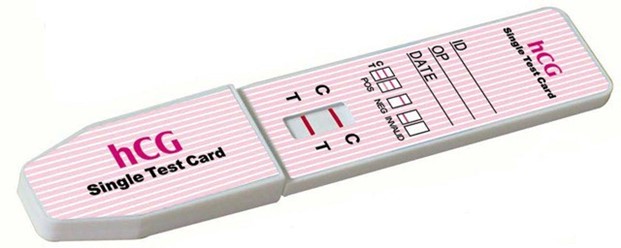The nurse is conducting an annual examination on a young female who reports her last menses was 2 months ago.
Although the client insists she is not pregnant due to a negative home pregnancy test, which assessment should the nurse prioritize to assess for a possible pregnancy?
A positive urine hCG.
Uterine size and shape changes.
A fetal heartbeat.
Chadwick's sign.
The Correct Answer is A
A positive urine hCG test is a priority assessment to assess for a possible pregnancy.
The human chorionic gonadotropin (hCG) hormone is produced by the placenta after implantation and can be detected in the urine of pregnant women.
A urine hCG test is a common method used to confirm pregnancy.

Choice B is not an answer because changes in uterine size and shape occur later in pregnancy and are not a priority assessment for early pregnancy detection.
Choice C is not an answer because a fetal heartbeat can usually be detected at around 6-7 weeks of pregnancy and is not a priority assessment for early pregnancy detection.
Choice D is not an answer because Chadwick’s sign, which refers to the bluish discoloration of the cervix, vagina, and vulva due to increased blood flow, occurs later in pregnancy and is not a priority assessment for early pregnancy detection.
Nursing Test Bank
Naxlex Comprehensive Predictor Exams
Related Questions
Correct Answer is B
Explanation
The nurse should instruct the parents to bring the infant’s favorite blanket to the hospital.
This can provide comfort and a sense of familiarity for the infant during their hospital stay.
Choice A is incorrect because reading a story about hospitalization to an 8- month-old infant may not be developmentally appropriate.
Choice C is incorrect because parents are usually allowed to stay with their infant during hospitalization.
Choice D is incorrect because manipulating the infant’s bedtime based on the hospital’s visiting hours is not necessary.
Correct Answer is B
Explanation
28 to 40 pounds (13 to 18 kilograms).
Women with a low BMI (under 18.5) should gain between 28 to 40 pounds (13 to 18 kilograms) throughout their pregnancy.
Choice A, 15 to 25 pounds (7 to 11 kilograms), is incorrect because it is the recommended weight gain for women who are overweight before pregnancy.
Choice C, 16 to 30 pounds (7.25 to 14 kilograms), is incorrect because it does not fall within the recommended weight gain range for women with a low BMI.
Choice D, 25 to 35 pounds (11 to 16 kilograms), is incorrect because it is the recommended weight gain for women who are at a healthy weight before pregnancy.
Whether you are a student looking to ace your exams or a practicing nurse seeking to enhance your expertise , our nursing education contents will empower you with the confidence and competence to make a difference in the lives of patients and become a respected leader in the healthcare field.
Visit Naxlex, invest in your future and unlock endless possibilities with our unparalleled nursing education contents today
Report Wrong Answer on the Current Question
Do you disagree with the answer? If yes, what is your expected answer? Explain.
Kindly be descriptive with the issue you are facing.
